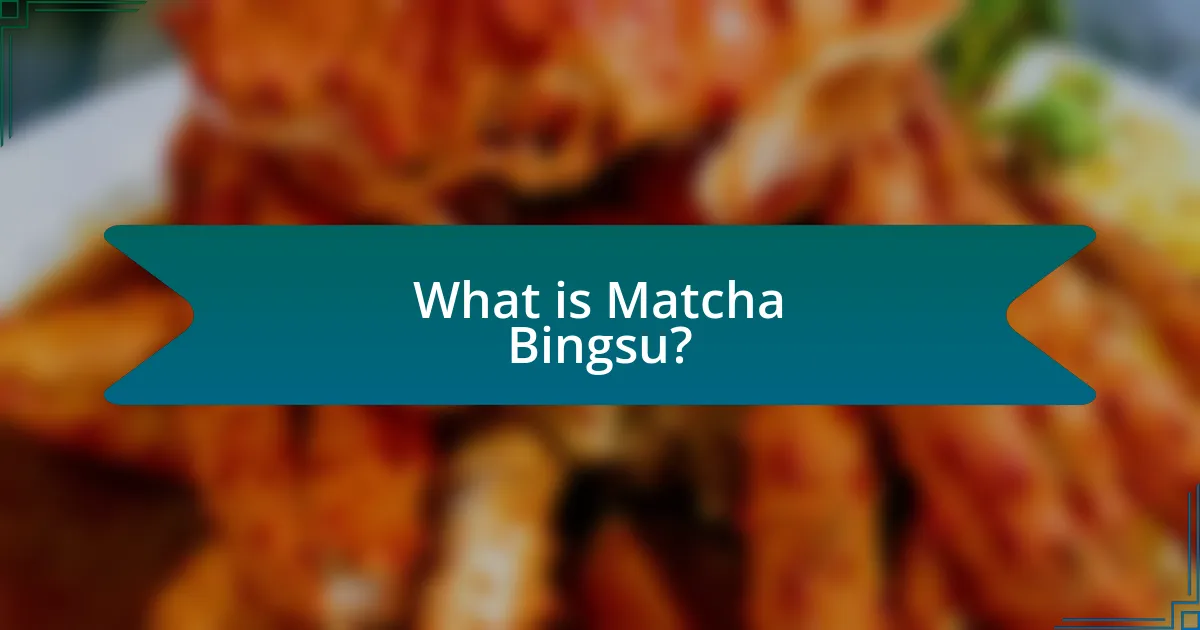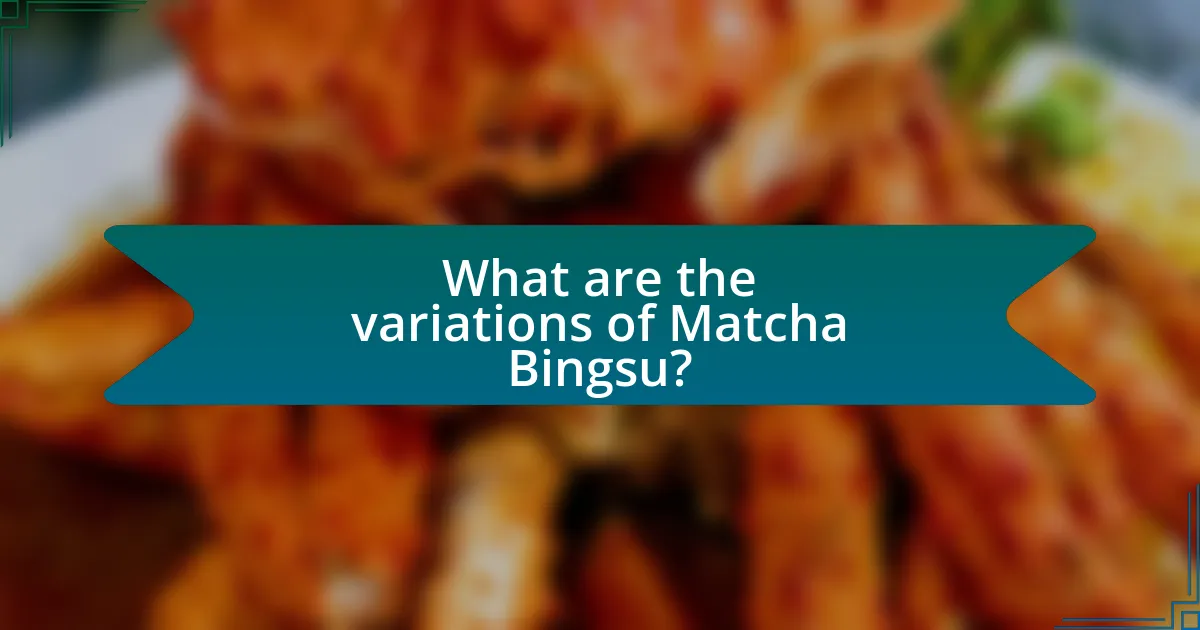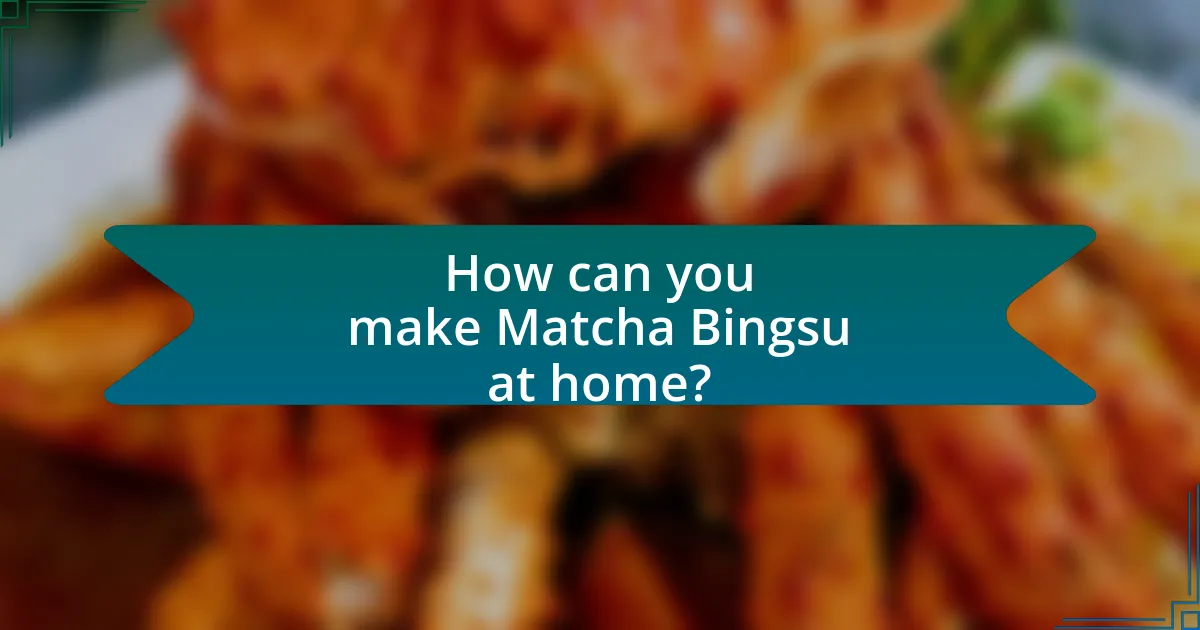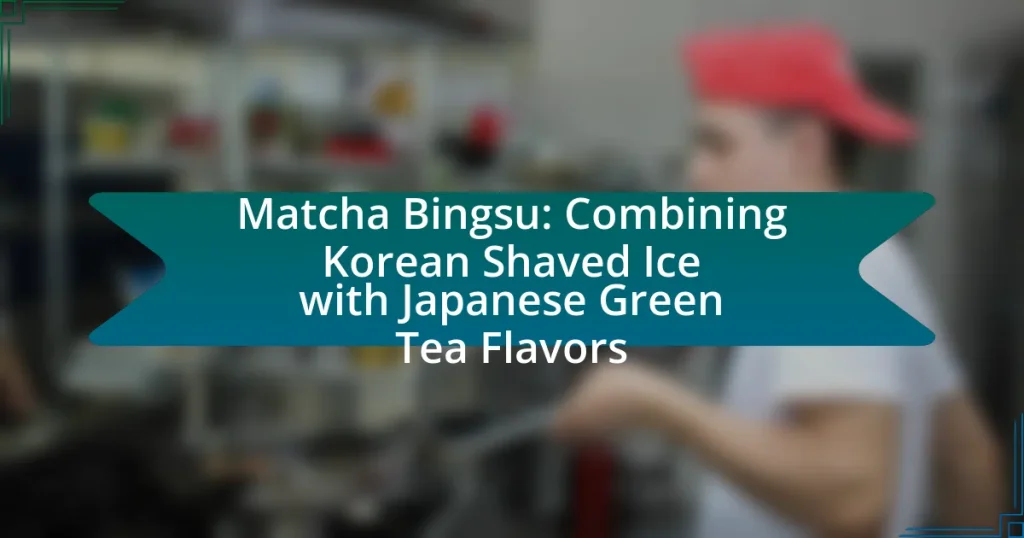Matcha Bingsu is a Korean dessert that combines finely shaved ice with matcha, a powdered green tea from Japan, creating a unique fusion of flavors. Originating in South Korea during the 2000s, this dessert reflects the cultural exchange between Korean and Japanese culinary traditions. The article explores the key ingredients, the evolution of Matcha Bingsu, its popularity in contemporary cuisine, and the influence of social media on its rise. Additionally, it discusses regional variations, creative toppings, and provides guidance on how to make Matcha Bingsu at home, including tips for achieving the perfect texture and flavor.

What is Matcha Bingsu?
Matcha Bingsu is a Korean dessert that features finely shaved ice topped with matcha, a powdered green tea from Japan. This dessert combines the traditional Korean bingsu, known for its fluffy ice texture, with the rich, earthy flavors of matcha, creating a unique fusion of tastes. The matcha used in bingsu is often complemented by various toppings such as sweetened condensed milk, red beans, or mochi, enhancing the overall flavor profile and texture.
How did Matcha Bingsu originate?
Matcha Bingsu originated from the fusion of traditional Korean bingsu, a shaved ice dessert, and matcha, a finely ground green tea powder from Japan. This combination emerged as a popular dessert in South Korea during the 2000s, reflecting the growing influence of Japanese culinary elements in Korean cuisine. The use of matcha in bingsu enhances the flavor profile, offering a unique blend of sweetness and earthy notes, which has contributed to its widespread appeal in cafes and dessert shops across South Korea and beyond.
What cultural influences shaped the creation of Matcha Bingsu?
Matcha Bingsu was shaped by the cultural influences of both Korean and Japanese culinary traditions. The Korean dessert, Bingsu, is a popular shaved ice treat that has been enjoyed for centuries, often topped with various ingredients such as fruits, sweetened red beans, and condensed milk. The incorporation of matcha, a finely ground green tea powder from Japan, reflects the growing popularity of Japanese flavors in Korean cuisine, particularly in the 21st century. This fusion highlights the cultural exchange between Korea and Japan, where matcha’s health benefits and unique flavor profile have been embraced in modern Korean desserts.
How has Matcha Bingsu evolved over time?
Matcha Bingsu has evolved from traditional Korean shaved ice desserts to a fusion delicacy that incorporates Japanese matcha flavors. Initially, bingsu was primarily made with sweetened red bean paste and various fruits, but the introduction of matcha in the early 2000s transformed its flavor profile, appealing to a broader audience. The rise of matcha’s popularity globally, particularly in the 2010s, led to innovative variations of bingsu, including toppings like matcha ice cream, mochi, and condensed milk, enhancing its visual appeal and taste. This evolution reflects a growing trend in culinary fusion, where traditional dishes are reimagined to cater to contemporary tastes and preferences.
What are the key ingredients in Matcha Bingsu?
The key ingredients in Matcha Bingsu are finely shaved ice, matcha green tea powder, sweetened condensed milk, and various toppings such as red bean paste, mochi, and fruits. Finely shaved ice serves as the base, providing a light and fluffy texture. Matcha green tea powder adds a distinct flavor and vibrant color, while sweetened condensed milk enhances the sweetness. Toppings like red bean paste and mochi contribute additional flavors and textures, making the dessert a harmonious blend of Korean and Japanese culinary elements.
What role does matcha play in the flavor profile of Matcha Bingsu?
Matcha serves as the primary flavor component in Matcha Bingsu, imparting a distinct earthy and slightly bitter taste that balances the sweetness of the dessert. This unique flavor profile is derived from matcha’s high-quality green tea leaves, which are finely ground, allowing for a concentrated infusion of umami and a vibrant green color. The presence of matcha not only enhances the overall taste but also contributes to the aesthetic appeal of Matcha Bingsu, making it visually striking and flavorful.
How does the texture of shaved ice contribute to the overall experience?
The texture of shaved ice significantly enhances the overall experience by providing a light, fluffy consistency that allows for easy melting in the mouth. This unique texture contrasts with denser desserts, creating a refreshing sensation that complements the flavors of matcha and other toppings. The finely shaved ice absorbs syrups and flavors more effectively, resulting in a harmonious blend that elevates the taste profile. Studies indicate that texture plays a crucial role in food enjoyment, as it influences perceptions of freshness and satisfaction, making the experience of consuming matcha bingsu more enjoyable.
Why is Matcha Bingsu popular in contemporary cuisine?
Matcha Bingsu is popular in contemporary cuisine due to its unique blend of flavors and visual appeal. This dessert combines the traditional Korean shaved ice with the rich, earthy taste of Japanese matcha, creating a refreshing treat that caters to diverse palates. The increasing health consciousness among consumers also contributes to its popularity, as matcha is known for its antioxidant properties and potential health benefits. Additionally, the vibrant green color of matcha enhances the aesthetic presentation of the dish, making it highly Instagrammable and appealing to the social media-savvy generation.
What trends have contributed to the rise of Matcha Bingsu?
The rise of Matcha Bingsu has been significantly influenced by the growing popularity of matcha as a health-conscious ingredient. This trend is supported by matcha’s high antioxidant content and its association with wellness, which has attracted consumers seeking healthier dessert options. Additionally, the increasing interest in Asian cuisine and desserts, particularly among millennials and Gen Z, has further propelled the demand for unique and visually appealing treats like Matcha Bingsu. Social media platforms, especially Instagram, have played a crucial role in showcasing the vibrant green color and artistic presentation of Matcha Bingsu, making it a trendy choice for food enthusiasts.
How does social media influence the popularity of Matcha Bingsu?
Social media significantly boosts the popularity of Matcha Bingsu by facilitating visual sharing and engagement among users. Platforms like Instagram and TikTok allow users to post aesthetically pleasing images and videos of Matcha Bingsu, which attracts attention and encourages others to try it. For instance, the hashtag #MatchaBingsu has garnered millions of posts, showcasing its appeal and driving trends. This visual marketing creates a viral effect, where the more people see and share these posts, the more likely they are to seek out and consume Matcha Bingsu, thereby increasing its popularity.

What are the variations of Matcha Bingsu?
Variations of Matcha Bingsu include traditional Matcha Bingsu, which features finely shaved ice topped with matcha powder, sweetened condensed milk, and red bean paste. Other popular variations are Matcha Bingsu with fruit toppings like strawberries or mango, and Matcha Bingsu with additional ingredients such as mochi, ice cream, or nuts. Each variation enhances the flavor profile and texture, appealing to diverse preferences while maintaining the core elements of the dessert.
How do different regions interpret Matcha Bingsu?
Different regions interpret Matcha Bingsu by incorporating local ingredients and flavors that reflect their culinary traditions. In South Korea, Matcha Bingsu is often served with sweetened condensed milk, red bean paste, and various fruits, emphasizing a balance of sweetness and texture. In contrast, regions like Japan may focus on a more minimalist approach, highlighting the quality of the matcha itself, often pairing it with simple toppings like mochi or a light syrup. This variation showcases how cultural preferences influence the presentation and flavor profile of Matcha Bingsu, making it a versatile dessert that adapts to regional tastes.
What unique ingredients are used in regional variations?
Regional variations of Matcha Bingsu incorporate unique ingredients such as red bean paste, mochi, and seasonal fruits. In Korea, red bean paste is commonly used as a sweet topping, while mochi adds a chewy texture. Additionally, fruits like strawberries and mangoes are often included to enhance flavor and presentation. These ingredients reflect local tastes and preferences, making each regional version distinct.
How do presentation styles differ across regions?
Presentation styles differ across regions primarily due to cultural preferences and aesthetic values. In East Asia, particularly in Korea, presentation often emphasizes vibrant colors and elaborate arrangements, as seen in Matcha Bingsu, where the dessert is topped with various ingredients like fruits and sweetened condensed milk, creating a visually appealing dish. Conversely, in Japan, presentation tends to focus on minimalism and simplicity, highlighting the natural beauty of ingredients, which is reflected in the way matcha is served, often in a more subdued manner with fewer toppings. This distinction is supported by cultural practices; for instance, the Japanese tea ceremony emphasizes harmony and simplicity, while Korean dining often celebrates abundance and variety.
What are some creative toppings for Matcha Bingsu?
Creative toppings for Matcha Bingsu include sweet red bean paste, mochi, fresh fruits like strawberries and mangoes, condensed milk, and matcha-flavored ice cream. These toppings enhance the dessert’s flavor profile and texture, providing a balance of sweetness and creaminess. For instance, sweet red bean paste adds a traditional element, while fresh fruits contribute freshness and acidity, making the dish more complex and enjoyable.
How do toppings enhance the flavor and texture of Matcha Bingsu?
Toppings enhance the flavor and texture of Matcha Bingsu by adding contrasting tastes and varying mouthfeel. For instance, sweetened red beans provide a rich, earthy flavor that complements the bitterness of matcha, while fruits like strawberries or mangoes introduce a refreshing sweetness and juiciness. Additionally, crunchy elements such as nuts or granola contribute a satisfying texture that contrasts with the smoothness of the shaved ice. This combination of flavors and textures creates a more complex and enjoyable dessert experience, appealing to a wider range of palates.
What are popular seasonal toppings for Matcha Bingsu?
Popular seasonal toppings for Matcha Bingsu include fresh fruits like strawberries, mangoes, and peaches, as well as red bean paste and mochi. These toppings enhance the flavor profile and texture of the dish, making it more appealing during different seasons. For instance, strawberries are commonly used in spring, while mangoes are favored in summer due to their sweetness and juiciness. The combination of these toppings with the matcha base creates a refreshing dessert that aligns with seasonal availability and consumer preferences.

How can you make Matcha Bingsu at home?
To make Matcha Bingsu at home, start by preparing the shaved ice using a blender or ice shaver to create fine ice flakes. Next, mix matcha powder with sweetened condensed milk and a bit of water to create a matcha syrup. Layer the shaved ice in a bowl, drizzle the matcha syrup over the top, and add toppings such as red bean paste, mochi, or fresh fruits. This method combines the traditional Korean dessert with the distinct flavor of Japanese green tea, resulting in a refreshing treat.
What equipment do you need to prepare Matcha Bingsu?
To prepare Matcha Bingsu, you need an ice shaver, a mixing bowl, a whisk, and serving bowls. The ice shaver is essential for creating the fine, fluffy ice texture characteristic of Bingsu. A mixing bowl and whisk are necessary for blending the matcha powder with water or milk to create the matcha syrup. Finally, serving bowls are required to present the finished dessert. These pieces of equipment are fundamental for achieving the authentic taste and texture of Matcha Bingsu.
How do you achieve the perfect shaved ice consistency?
To achieve the perfect shaved ice consistency, use finely crushed ice that resembles snow rather than coarse chunks. This can be accomplished by utilizing a high-quality ice shaver designed for achieving a fluffy texture, which allows the ice to melt slowly and absorb flavors without becoming watery. The ideal ice should be compacted and chilled to a temperature just below freezing, ensuring it maintains its structure while being served. Studies indicate that the texture of shaved ice significantly impacts the overall experience, with finer ice providing a smoother mouthfeel and better flavor integration.
What are the steps to prepare matcha syrup for Matcha Bingsu?
To prepare matcha syrup for Matcha Bingsu, first, combine equal parts of granulated sugar and water in a saucepan. Heat the mixture over medium heat, stirring until the sugar fully dissolves. Next, remove the saucepan from heat and whisk in matcha powder until fully incorporated, ensuring there are no lumps. Allow the syrup to cool before using it on the shaved ice dessert. This method is effective as it creates a smooth, sweet matcha syrup that enhances the flavor of Matcha Bingsu.
What tips can enhance your Matcha Bingsu experience?
To enhance your Matcha Bingsu experience, consider using high-quality matcha powder, as its flavor and color significantly impact the dessert’s overall quality. High-grade matcha, such as ceremonial grade, offers a richer taste and vibrant green hue, elevating the sensory experience. Additionally, pairing the bingsu with toppings like sweetened red beans, mochi, or fresh fruits can create a delightful contrast in textures and flavors, making each bite more enjoyable. The combination of these elements not only enhances the taste but also adds visual appeal, contributing to a more satisfying dessert experience.
How can you customize Matcha Bingsu to suit your taste preferences?
You can customize Matcha Bingsu by adjusting the toppings, sweetness level, and base ingredients to match your taste preferences. For instance, you can choose various toppings such as fresh fruits like strawberries, mangoes, or bananas, as well as nuts, mochi, or red bean paste to enhance flavor and texture. Additionally, you can modify the sweetness by adding more or less condensed milk or sweeteners, allowing for a personalized level of sweetness. Furthermore, you can experiment with the base by using different types of ice, such as coconut or fruit-flavored ice, to create a unique flavor profile. This flexibility in ingredients and toppings allows for a tailored dessert experience that caters to individual tastes.
What common mistakes should you avoid when making Matcha Bingsu?
When making Matcha Bingsu, avoid using low-quality matcha, as it can lead to a bitter taste and poor flavor profile. High-quality matcha, characterized by its vibrant green color and smooth texture, is essential for achieving the authentic taste of this dessert. Additionally, do not skip the step of properly chilling the ingredients, as warm components can cause the shaved ice to melt too quickly, resulting in a soupy consistency. Lastly, avoid overloading the bingsu with toppings; a balanced approach ensures that the matcha flavor remains prominent and the dessert is enjoyable.


